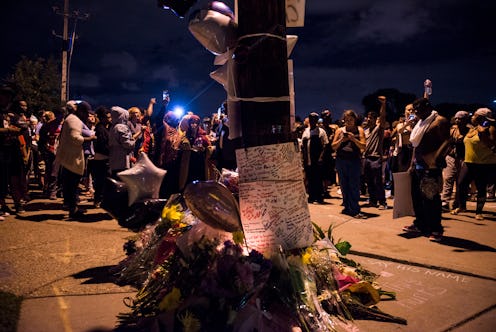News
Was Philando Castile Racially Profiled?
A day after Alton Sterling was shot and killed by a police officer in Baton Rouge, Louisiana, Minnesota resident Philando Castile was killed by a police officer during what should have been a routine traffic stop. These traffic stops, it turns out, really were "routine" for Castile: According to the Associated Press, Philandro Castile had been stopped by police at least 52 times in recent years. Most of the stops were for minor traffic violations like speeding and not wearing a seat belt, but in the aftermath of Castile's sudden death in the front seat of his own car, there's growing speculation that Castile was the target of racial profiling — again, and again, and again.
Castile was reportedly pulled over in a St. Paul, Minnesota, suburb on Wednesday for a broken taillight. His girlfriend, Diamond Reynolds, and her 4-year-old daughter were also in the car at the time. Reynolds, in a video originally posted to her Facebook page, confirmed moments after Castile was shot that the officers stopped the car because of the taillight.
But a broken taillight is not an offense deserving of four gunshots to the chest, and though Castile had a gun in the car, he was licensed to carry. Reynolds said Castile informed the police officer that he was licensed to carry and had a firearm on him, which is protocol for any gun owner.
Although the AP reported that Castile had been involved in traffic stops 52 times, an NBC News analysis places that number slightly lower. NBC's Tom Winter tweeted on Thursday that court records revealed Castile had been stopped by police 31 times since the early 2000s. What we do know is that Castile was pulled over multiple times a year, and given citations for minor infractions.
But what went wrong at this traffic stop? And why was Castile routinely targeted by police officers in his area?
Minnesota Gov. Mark Dayton believes that Castile was stopped and tragically shot to death because he was a black man. "Would this have happened if those passengers, the driver were white?" Dayton said on Thursday. "I don't think it would have."
The governor added: "No one should be shot in Minnesota for a taillight being out of function. No one should be killed in Minnesota while seated in their car."
Dayton may have a strong point about how race played into Castile's final moments. St. Paul news station KARE 11 obtained a police scanner recording that reveals Castile may have been pulled over because he supposedly resembled a robbery suspect. The officer says on the police scanner recording, "The driver looks more like one of our suspects, just ‘cause of the wide set nose."
Castile's uncle, Clarence Castile, told the news station this was clear racial profiling. "I just thought it was kind of insane to pull somebody over saying they matched a robbery suspect by having flared nostrils," he told KARE 11.
Reynolds said in her Facebook video that the officer pulled them over for the taillight; there was no mention of the reported robbery. The officer radioed in "shots fired" just minutes after the comment about the robbery suspects.
Racial profiling during police traffic stops is real. Just look at Ferguson, Missouri, the St. Louis suburb where 18-year-old unarmed teenager Michael Brown was shot and killed by a white police officer in August 2014. A Missouri state report released in 2015 revealed that 90 percent of traffic stops in Ferguson involved African-American citizens; white citizens were the least likely to get pulled over.
The National Institute of Justice also confirms that African-Americans are more likely on a national basis to be stopped by police officers than white Americans. Some studies point toward both racial bias and driving patterns; the NIJ pointed to a study on how African-Americans are less likely to wear seat belts, which would make them targets of police departments who heavily impose seat belt regulations.
Philando Castile had some seat belt offenses on his driving record. Does this mean Castile was just a habitually bad driver? Well, the number of his traffic stops still hint at systemic and racial biases rather than bad driver's luck.
